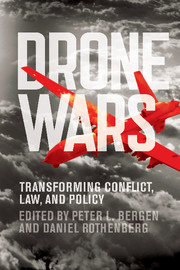Book contents
- Frontmatter
- Contents
- Contributors
- Acknowledgments
- Introduction
- Part I Drones on the Ground
- Part II Drones and the Laws of War
- Part III Drones and Policy
- 11 “Bring on the Magic”
- 12 The Five Deadly Flaws of Talking About Emerging Military Technologies and the Need for New Approaches to Law, Ethics, and War
- 13 Drones and Cognitive Dissonance
- 14 Predator Effect
- 15 Disciplining Drone Strikes
- 16 World of Drones
- Part IV Drones and the Future of War
- Index
- References
14 - Predator Effect
A Phenomenon Unique to the War on Terror
Published online by Cambridge University Press: 05 December 2014
- Frontmatter
- Contents
- Contributors
- Acknowledgments
- Introduction
- Part I Drones on the Ground
- Part II Drones and the Laws of War
- Part III Drones and Policy
- 11 “Bring on the Magic”
- 12 The Five Deadly Flaws of Talking About Emerging Military Technologies and the Need for New Approaches to Law, Ethics, and War
- 13 Drones and Cognitive Dissonance
- 14 Predator Effect
- 15 Disciplining Drone Strikes
- 16 World of Drones
- Part IV Drones and the Future of War
- Index
- References
Summary
Drones and the CIA: A Model for Future Wars?
The widespread deployment of robotic systems in combat is one of the most significant technical advancements of the post-9/11 era. The technology that has attracted by far the most attention is the Predator, an armed drone used by the United States for reconnaissance and to conduct precision missile strikes on targets in many parts of the world. The US military has used Predators in the wars in Afghanistan and Iraq, as part of NATO operations in Libya, and for more than 400 air strikes on terrorist targets in Yemen, Pakistan, Somalia, and the Philippines. The Predator has become a poster-child for the war on terror and some government officials have lauded it as the “the only game in town” for disrupting al-Qaeda. In light of the Predator’s widespread deployment and significant impact, it has become fairly common to hear that drones represent a revolutionary technology and herald a new era of warfare. Michael O’Hanlon, a defense policy expert at the Brookings Institution, has gone so far as to declare that “the era of manned airplanes should be seen as over.”
Despite the obvious novelty of drone use, these claims are both overly broad and excessively narrow. Arguments predicting a drone revolution are too broad, in part because commentators refer to drones as a single class of technology when in fact that there are many types of drones that are used in a variety of ways. While the US military has dozens of different types of drones (and other militaries have many additional versions), a significant amount of commentary focuses on armed Predator drones. Yet even discussions on the Predator are often too narrow because they focus on the transformative impact of the technology without considering the impact of the organizations and policies controlling drone operations, which may represent the predominant drivers of change.
- Type
- Chapter
- Information
- Drone WarsTransforming Conflict, Law, and Policy, pp. 253 - 284Publisher: Cambridge University PressPrint publication year: 2014
References
- 2
- Cited by



